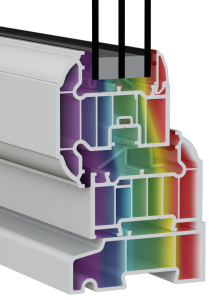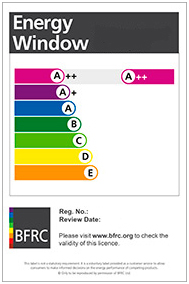Description
Eurocell Logik Ovolo
U-values as low as 1.2 can be achieved with a double-glazed unit and 0.8 with a triple-glazed unit.
Efficient windows
Delivering superior energy efficiency has never been more important for the construction industry and homeowners. It’s an alarming fact that our homes and buildings are responsible for almost half of the UK’s carbon dioxide emissions. Windows have an important role to play in combating energy wastage, since 20% of the heat escaping from an average home is lost through its windows High-performance products
Exposed to the elements, windows need to be hard-wearing, weather resistant and long lasting. The Eurocell Logik window system will enable you to meet and exceed all of these requirements.
Up to 10 year guarantee
Eurocell Logik windows and doors are guaranteed for ten years, so you can give you the assurance of a robust, well-designed, precision-made product that’s built to last – manufactured by the UK’s leading PVC-U specialist.
Measuring Doors

- All measurements to be taken from external openings
- When measuring always measure in millimetres
- Measure the width of the opening in 3 places:
- Bottom of opening left to right
- Middle of opening left to right
- Top of opening left to right
- Measure the height of the opening in 3 places:
- Left of opening top to bottom
- Middle of opening top to bottom
- Right of opening top to bottom
Take the smallest measurement for the width and the smallest for the height and take off 10mm off each of them e.g. Window opening = 1800mm width x 1000mm height Deduct 10mm from the width and height = 1790mm width x 990mm height The above dimensions will be the manufacturing/order sizes that you will need to input when ordering windows and doors from our website. You deduct 10mm from the width and height to allow for tolerance when fitting.
10 Year Guarantee
We give a 10-year guarantee on all bespoke PVC-U products, which you buy from Window Supply Direct LTD. This guarantee is to be read in conjunction with the Terms and Conditions. We guarantee that our products will not:
- Warp
- Discolour
- Lose their strength
- Rot
- Peel or crack
There is a 5-year guarantee on all glazed units. This includes a break down of the unit, which could give the appearance of misting in the glass. This guarantee does not include broken units after they have been delivered. We offer a 12-month guarantee on all hardware including handles, locks and hinges. This guarantee does not guarantee the product against general fair wear and tear of the item. General fair wear and tear on products which is not included in the guarantee include:
- Scratches on handles, glass, frames, trickle vents and hinges
- Damage to letter boxes
- Broken keys in locks
Looking After Your New PVC-U Windows and Doors
General Maintenance
- Use warm soapy water to clean frames with soft cloth or soft bristled brush
- Use non-alkaline solution when cleaning the frames
- Do not use strong abrasive cleaners, wire brushes or wire wool when cleaning.
- Lubricate moving parts annually.
Energy Rating
Up to 20% of your home’s heat can be lost through your windows. That’s why it’s important to make sure your new ones are as energy efficient as possible.
As a homeowner, you may think, “How am I supposed to know what is energy efficient and what isn’t?”
To simplify things, lets start by talking about how a window is made up. Every part can affect its energy rating…
 The frame is the best starting point. uPVC is a natural insulator, so it’s one of the most energy efficient materials for a window frame. In a Liniar window, multiple chambers hide inside the frame, acting as barriers and making it harder for the heat inside your home to be transferred through and escape outside. The drawing on the left shows the Liniar EnergyPlus system, with the colours representing heat and cold – with red being the heat from your home and purple the cold air coming from the outside.
The frame is the best starting point. uPVC is a natural insulator, so it’s one of the most energy efficient materials for a window frame. In a Liniar window, multiple chambers hide inside the frame, acting as barriers and making it harder for the heat inside your home to be transferred through and escape outside. The drawing on the left shows the Liniar EnergyPlus system, with the colours representing heat and cold – with red being the heat from your home and purple the cold air coming from the outside.
Glazing also plays a huge part in energy efficiency. Double glazing is still the most popular choice, although triple glazing is increasing in popularity in the UK. Double or triple refers to the layers of glass that are used back to back in your window. There is a wide range of types of glass that can be used, and you may hear the term “low emissivity glass or low-e glass”, which has an invisible coating to reflect heat back into your home
Whatever glazing you choose, one thing they all have in common is a spacer bar in between the panes. This is the long continuous strip of material that is sealed to the glass to separate the panes. Spacer bars are typically made from aluminium or a low heat conductive material – you might hear these referred to as “warm edge spacers.” A spacer does what it says on the tin, but not only spaces the glazed panels, it helps prevent the transfer of heat too. The space created between the panes of glazing is often filled with gas – usually either air, argon or krypton.
Ok, so you’ve got a frame, glazing, spacer bar and gas. But how is an energy rating calculated?
The bots at the BFRC (British Fenestration Ratings Council) calculate a windows energy rating based on
- U-Value (of the glass Ug & the frame Uf)
- the solar heat gain or ‘G Value’ (of the glass)
- air leakage rate of all the components of the fitted window.
Phew!
The U-Value is something that is quite often talked about and something you might see when talking about energy ratings. A U-value is the measure of the heat loss in watts (W) per square metre (m²) of material when the temperature (K) outside is at least 1 degree cooler – (complex stuff) you will see it written as W/m²K!

When the u-value has been calculated it is combined with the solar gain of the glass and the window is given a numerical BFRC rating – the WER, or Window Energy Rating. To make things simpler, this is converted to a band, which now runs from A++ to G. The rating is displayed on a lovely rainbow label – this may look familiar, as similar labels should be on the back of your fridge, freezer and other white goods.
I’m reliably informed by my tech-bot friends that the rainbow label used to start with A+ in the purple band at the top – but from 1st October 2015 this year, when the BFRC bots realised that windows (and the bots behind them) were getting very clever at keeping heat where it should be, they created a new category *drum roll* the A++ category! Luckily, Liniar windows were already super efficient and so the system could achieve A++ well ahead of the new band.
So! To summarise…
The closer to having a WER of A++, and the lower the U-value is, the more energy efficient the window or door is, meaning lower fuel bills for human-bots.




 The frame is the best starting point. uPVC is a natural insulator, so it’s one of the most energy efficient materials for a window frame. In a Liniar window, multiple chambers hide inside the frame, acting as barriers and making it harder for the heat inside your home to be transferred through and escape outside. The drawing on the left shows the Liniar EnergyPlus system, with the colours representing heat and cold – with red being the heat from your home and purple the cold air coming from the outside.
The frame is the best starting point. uPVC is a natural insulator, so it’s one of the most energy efficient materials for a window frame. In a Liniar window, multiple chambers hide inside the frame, acting as barriers and making it harder for the heat inside your home to be transferred through and escape outside. The drawing on the left shows the Liniar EnergyPlus system, with the colours representing heat and cold – with red being the heat from your home and purple the cold air coming from the outside.